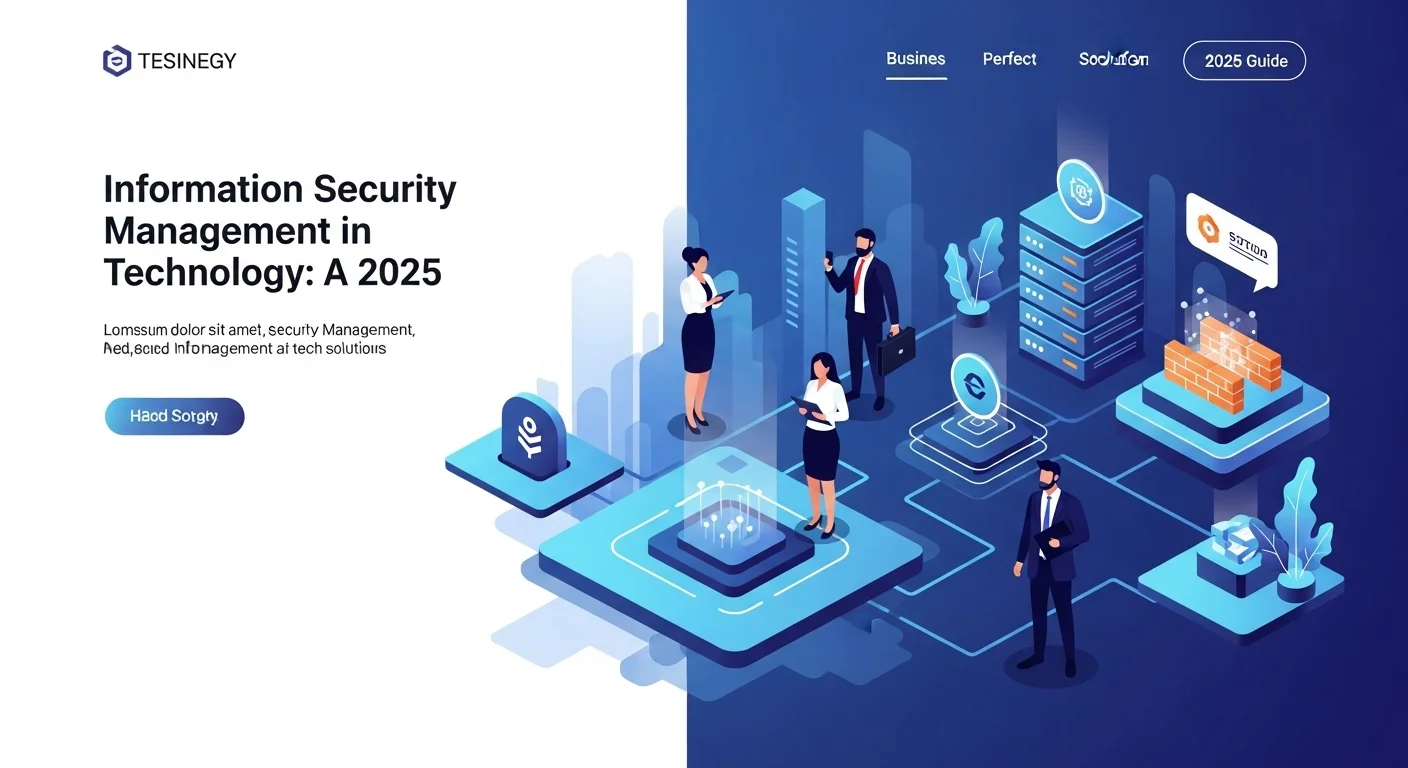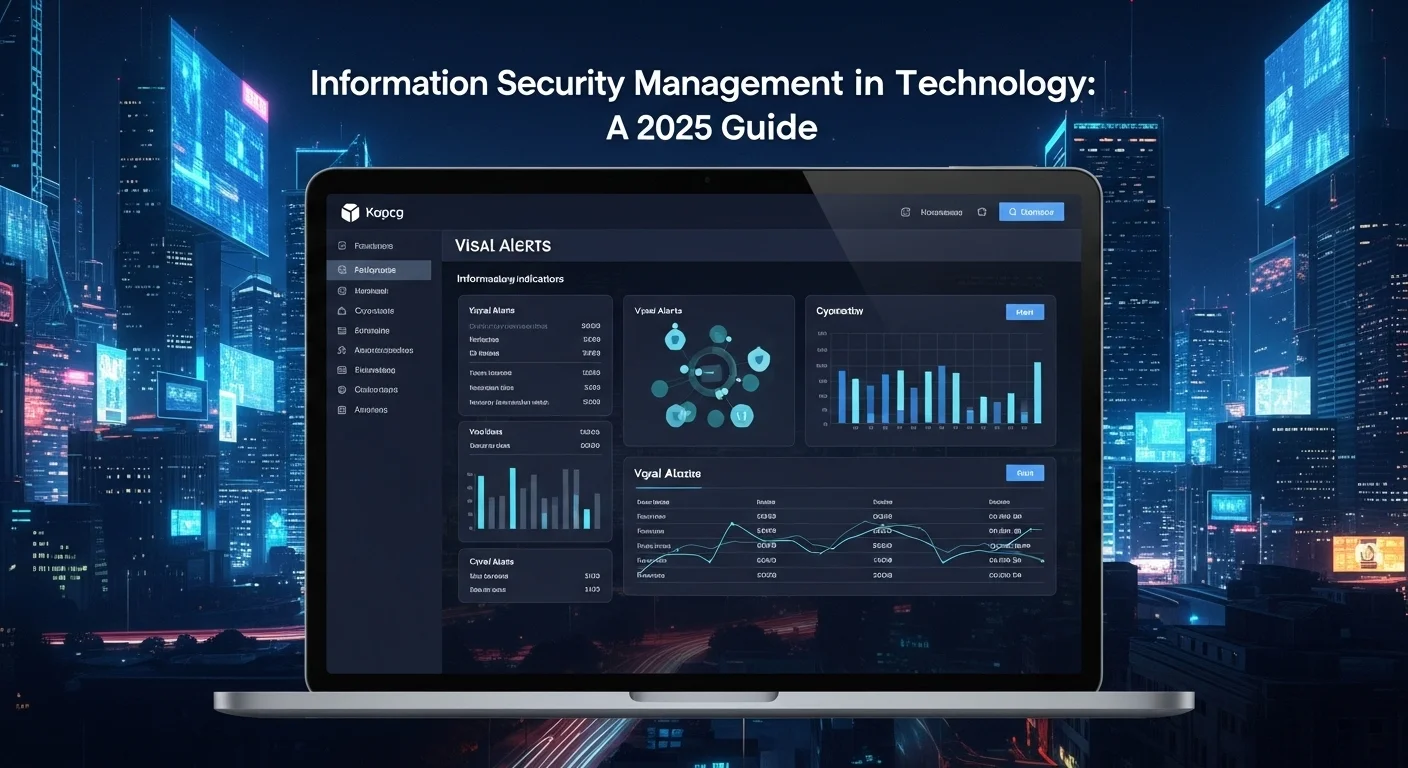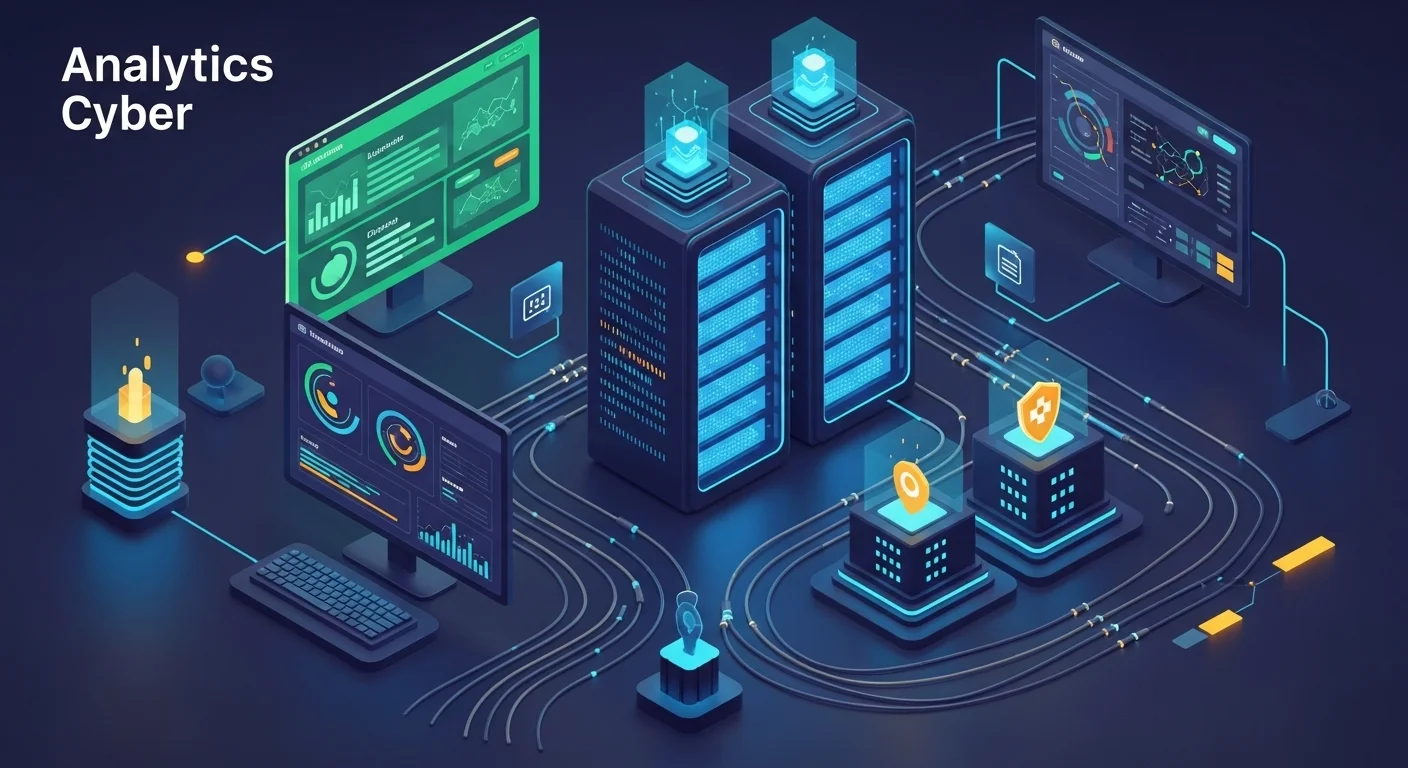Keeping Your Business Safe: A Real-World Guide to Information Security

Executive Summary
I've spent over a decade in the cybersecurity field, and if there's one thing I've learned, it's that information security isn't just a tech problem—it's a core business strategy for survival and growth. In a world powered by data, protecting that data is everything. This guide is my attempt to cut through the noise and give you a straight-talking look at what Information Security Management really means. We'll explore the essential principles, like the famous CIA triad, and make sense of powerful frameworks like ISO 27001 and NIST. My goal is to equip you, whether you're a business leader or a tech professional, with the knowledge to manage risk, ensure compliance, and build a truly resilient organization. We'll cover how security and risk management go hand-in-hand and how to weave security into every project and service you deliver. Think of this as your personal roadmap to navigating the crucial, complex world of digital protection.
Table of Contents
Table of Contents
What is Information Security Management, Really?
Let's simplify things. Information Security Management, or ISM, is your company's game plan for keeping its sensitive information safe. It’s not just about buying antivirus software or setting up a firewall. It's a complete system involving your people, your daily processes, and the tech you use to protect your digital assets. At its heart, ISM is about understanding what information is valuable and then taking smart, organized steps to protect it from all kinds of threats. The main goal is to keep your business running smoothly, reduce the damage if a security incident does happen, and protect the three pillars of your information: its confidentiality, integrity, and availability (we'll call this the CIA triad).
Think about it: in today's world, data is like currency. Every customer email, financial report, or product design is a valuable asset. And just like any other asset, it comes with risks. A solid ISM strategy is what stands between that valuable data and those who might misuse it.
The Core of Security: Confidentiality, Integrity, and Availability
I've always found the CIA triad to be the perfect way to explain the fundamentals of security. It's the foundation upon which everything else is built:
- Confidentiality: This is the 'secret-keeping' part. It's about making sure that information is only seen by the people who are supposed to see it. In practice, this means using tools like encryption and setting up access controls. A breach of confidentiality is what happens when customer data is stolen or a competitor gets their hands on your secret plans.
- Integrity: This ensures your information is trustworthy and accurate. It’s about preventing unauthorized changes to your data. Imagine the chaos if someone could alter financial records or medical histories. We use things like digital signatures and version control to maintain data integrity.
- Availability: This means that authorized users can get to the information they need, when they need it. It’s about keeping your systems up and running. A cyberattack or even a simple hardware failure can threaten availability, bringing your business to a grinding halt.
In my experience, trust is the currency of business. A single data breach can destroy the trust you've built with your customers. On top of that, we have regulations like GDPR and HIPAA, which come with massive fines for non-compliance. A strong ISM program isn't just good practice; it's essential for survival and navigating today's legal landscape.
Why Risk Management is Your Security Superpower
If ISM is the game plan, then managing risk is how you decide which plays to run. It's the process of finding, analyzing, and dealing with threats to your information. This is a proactive sport, not a reactive one. You don't wait for a fire to buy an extinguisher; you anticipate the possibility of a fire and prepare accordingly. The process is pretty logical:
- Identify Risks: What could possibly go wrong? This could be anything from a hacker trying to break in, an employee making an honest mistake, or even a natural disaster like a flood.
- Analyze Risks: For each risk, you ask two questions: How likely is it to happen? And how bad would it be if it did? This helps you prioritize what to worry about first.
- Treat Risks: Once you know your biggest risks, you decide what to do. You can reduce the risk (by adding a security control), transfer it (like buying cyber insurance), avoid it (by stopping a risky activity), or simply accept it (if the cost to fix it is more than the potential damage).
- Monitor and Review: The world of threats changes constantly. Risk management is a continuous cycle of monitoring your defenses and reviewing your risks to make sure your game plan is still effective.
You simply can't have effective security without first understanding your risks. This approach ensures you're spending your time and money wisely, protecting what matters most instead of chasing ghosts.
The Real-World Benefits for Your Business
A well-run ISM program touches every corner of your business. In finance, it protects transactions. In healthcare, it safeguards patient data. The benefits are clear and powerful:
- Asset Protection: The most obvious win. Your valuable information stays safe from harm, theft, or misuse.
- Business Resilience: When you're prepared for the worst, you can weather the storm. Your business can keep going even when faced with a security incident.
- Builds Trust: When customers, partners, and investors see you take security seriously, they trust you more. Your brand reputation gets a major boost.
- Stay Compliant: A good ISM program makes it much easier to meet legal and regulatory requirements, helping you avoid huge fines.
- Competitive Edge: In many fields, having a certified security program (like ISO 27001) can win you business with clients who demand high security standards.
As we embrace new tech like AI and the cloud, security becomes even more complex. But the principles remain timeless. You need to understand your assets, know your risks, and have a system to manage them. This is where you integrate security into your IT service frameworks (like ITIL), your project management, and your day-to-day cyber defense operations. It's about creating a complete shield, from strategic planning all the way to real-time threat response.

Complete Guide: Building Your Security Program with Business Solutions
Understanding the 'what' and 'why' of Information Security Management (ISM) is the first step. Now, let's get into the 'how.' Building a strong security program means using proven blueprints, the right tools, and smart business processes. This is where we create an Information Security Management System (ISMS)—the living, breathing entity that puts your security strategy into action every single day.
Choosing Your Blueprint: Popular Security Frameworks
You don't have to start from zero. I've worked with many companies, and leaning on an established framework is always the best path. These provide a structured, world-class approach.
- ISO/IEC 27001: Think of this as the international gold standard for an ISMS. It gives you a recipe for establishing, running, and continuously improving your security program. Getting certified is like earning a seal of approval that tells the world you're serious about security. It’s built on a 'Plan-Do-Check-Act' cycle, forcing constant improvement. A key part of it is deciding which of its 114 security controls you need based on your specific risks. It truly puts risk management at the center of everything.
- NIST Cybersecurity Framework (CSF): Developed in the U.S. but used globally, the NIST Cybersecurity Framework (CSF) is an incredibly practical and adaptable framework. It’s organized around five simple functions: Identify, Protect, Detect, Respond, and Recover. I love it because it creates a common language that everyone, from the server room to the boardroom, can understand. It's less about rigid rules and more about building resilience and managing risk in a way that fits your business.
- COBIT: This framework is broader than just security; it’s about the overall governance and management of your company's IT. I've seen it work wonders in large organizations to align IT goals with business strategy. It helps ensure that you're getting real value from your tech investments while keeping risks and resources in balance.
The Tech Toolkit: Essential Security Controls
Your ISMS needs a technical backbone. These are the tools and technologies that enforce your security rules on the ground.
- Access Control: This is like being the bouncer for your data. First, you check ID (authentication with passwords, biometrics, etc.). Then, you check the guest list to see where they're allowed to go (authorization). Finally, you keep an eye on what they do (accounting).
- Cryptography: This is the art of secret codes. Encryption scrambles your data so that it's unreadable to unauthorized people, whether it's sitting on a hard drive or flying across the internet. It's a non-negotiable for protecting sensitive information.
- Network Security: This is about protecting the digital highways your data travels on. We use firewalls as traffic cops, intrusion detection systems as security guards, and VPNs to create secure, private tunnels for remote workers.
- Vulnerability Management: No software is perfect. This is the continuous process of finding, prioritizing, and fixing security weaknesses in your systems. It involves regular scans and a solid plan for applying security patches before the bad guys can exploit them.
Beyond the Tech: People and Processes
I can't stress this enough: technology alone will never be enough. Your people and your processes are just as important.
- Security Policies and Procedures: These are your rulebooks. Policies are the high-level 'what' and 'why' of your security goals. Procedures are the detailed, step-by-step instructions on 'how' to perform security tasks.
- Security Awareness and Training: Your employees can be your greatest strength or your weakest link. A continuous training program is essential. It should teach them how to spot threats like phishing emails and understand their role in protecting the company.
- Incident Response Planning: It's not a question of *if* a security incident will happen, but *when*. You need a plan ready to go. This plan should detail exactly what to do to contain the threat, recover your systems, and—most importantly—learn from the experience to get stronger.
- Business Continuity and Disaster Recovery (BCDR): These are your 'what if the building burns down?' plans. They ensure your critical business functions can survive a major disruption, whether it’s a cyberattack or a natural disaster.
Integrating Security with ITIL, Project Management, and SIEM
To really succeed, security has to be part of the company's DNA. Integrating it with other management systems is how you do it. For example, using a framework like ITIL for IT service management, you ensure that every change to your IT environment is reviewed for its security impact. When an incident happens, your security response plan is already part of the process. This prevents security from being an afterthought.
Likewise, embedding security into project management is a game-changer. By thinking about security from day one of a new project—a concept we call 'Security by Design'—you build stronger, safer systems from the ground up. It's far cheaper and more effective than trying to bolt on security at the end.
Operationally, Security Information and Event Management (SIEM) systems are your eyes and ears. A SIEM tool gathers security logs from all over your network, connects the dots to spot suspicious activity, and alerts your team to potential threats. It's the nerve center for modern cyber defense, allowing you to detect and respond to threats in real-time.

Practical Tips and Strategies for Mastering Information Security
Making an Information Security Management (ISM) program successful is a marathon, not a sprint. It takes consistent effort and smart planning. Here are some of my go-to tips and strategies, learned from years in the trenches, to help you move from theory to true operational excellence in security and business resilience.
Best Practices for a Mature Security Program
These are the habits of highly effective security programs. I've seen them work time and time again.
- Get Leadership on Board: This is the most critical success factor, period. If your executive team doesn't support the program with resources and authority, it's doomed to fail. You need a champion in the C-suite and a formal steering committee to guide the strategy.
- Build a Security Culture: Your people are your first and last line of defense. You need to create a culture where everyone feels responsible for security. This means ongoing, engaging training, clear communication about threats, and celebrating good security habits. Phishing simulations are a great way to train people and see how well your program is working.
- Lead with Risk: Don't boil the ocean. You can't protect everything equally. Your best bet is to focus your energy on protecting your most critical information and tackling the most significant risks. A solid risk management process is non-negotiable and needs to be a living thing, constantly updated as your business and the threats evolve.
- Always Be Monitoring and Improving: The threat landscape is always shifting, so your defenses must too. You need a program for continuous monitoring to spot threats as they happen. This includes watching logs, scanning for vulnerabilities, and staying on top of threat intelligence. Use the 'Plan-Do-Check-Act' model from frameworks like ISO 27001 to always be looking for ways to get better.
- Layer Your Defenses (Defense-in-Depth): There's no single magic bullet for security. The best strategy is to use multiple layers of controls. If one layer fails, another is there to catch the threat. This applies to your tech (firewall + endpoint protection), your processes (separating duties), and your people (training + background checks).
My Go-To Tools for Security Management
The right tools can make your security program far more efficient and effective. Here are some categories I consider essential:
- Security Information and Event Management (SIEM): These are the nerve centers of a modern security operations center (SOC). They pull in all your security data, correlate it, and flag potential threats. Platforms like Microsoft Sentinel or Splunk are leaders here. You can't manage security at scale without one.
- Vulnerability Management Tools: These tools are your scouts, constantly scanning your systems for weaknesses. Solutions from Tenable, Qualys, or Rapid7 automate the hunt for vulnerabilities so you can fix them fast.
- Governance, Risk, and Compliance (GRC) Platforms: These tools help you manage the big picture. They provide a single place to track your policies, controls, risks, and compliance efforts, which is a lifesaver come audit time.
- Endpoint Detection and Response (EDR): Old-school antivirus just doesn't cut it anymore. EDR solutions like CrowdStrike or SentinelOne provide powerful threat detection and response capabilities right on your employees' laptops and servers.
- Identity and Access Management (IAM) Solutions: These tools manage who your users are and what they're allowed to access. They enforce strong authentication, simplify logins, and help you enforce the 'principle of least privilege.' Okta and Azure Active Directory are giants in this space.
Making Security Part of Your Company's DNA
For security to truly work, it can't live in a silo. It needs to be woven into the very fabric of your business.
- With ITIL and IT Services: Integrating security with ITIL ensures that it's a key part of every IT process. When a new service is being designed, security has a seat at the table. When an incident occurs, the security team is part of the response from the start.
- With Project Management: Every new project brings new risks. By building security into your project management lifecycle, you address these risks from day one. This means defining security requirements early, conducting risk assessments at key stages, and budgeting for security activities. Having a 'Security Champion' on the project team can make a huge difference.
- With Your Vendors: Your security is only as strong as your weakest partner. You need a strong program for managing third-party risk. This means vetting your vendors' security, writing security requirements into your contracts, and periodically checking up on them to make sure they're still meeting your standards.
By bringing together these strategies, practices, and tools, you can build a security program that doesn't just protect you from threats, but also empowers your business to innovate and grow with confidence. To dive deeper, I highly recommend checking out the official NIST Cybersecurity Framework website. It's a fantastic resource. Always remember, the powerful connection between understanding your risks and building your security is what leads to true, lasting cyber resilience.
Expert Reviews & Testimonials
Sarah Johnson, Business Owner ⭐⭐⭐⭐
As a small business owner, the world of cybersecurity can feel overwhelming. This article broke it down in a way that finally clicked. The practical examples on risk management were exactly what I needed. Still, I'd love to see a follow-up piece on low-budget security tools for startups.
Mike Chen, IT Consultant ⭐⭐⭐⭐⭐
Solid overview. I'm an IT consultant, and I'll be sharing this with clients who need to grasp the 'why' behind our security recommendations. It's a great bridge between the technical details and the business strategy.
Emma Davis, Tech Expert ⭐⭐⭐⭐⭐
Five stars, hands down. I'm studying for my CISSP, and this article was a fantastic refresher. It connects all the dots between frameworks, controls, and real-world application in a way textbooks often miss. Super clear and well-written!



